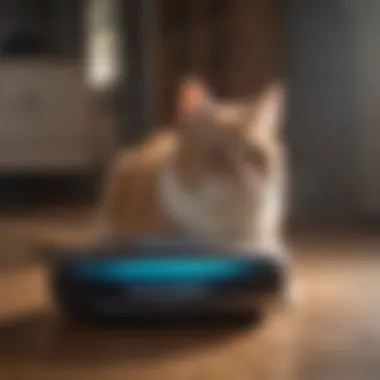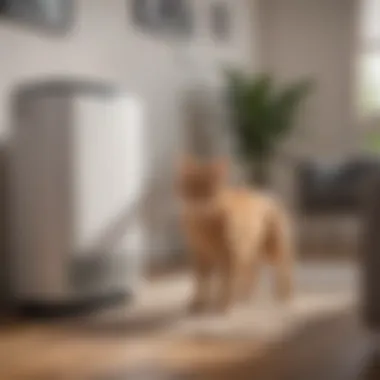Dangers of Ionizer Air Purifiers for Pets


Intro
As pet owners, we strive to create a safe and healthy environment for our furry companions. In our quest for improved air quality, many may consider various air purifiers, including ionizers. While these devices promise cleaner air, it is crucial to examine their implications, especially in homes with pets. This exploration will detail how ionization technology works, its effects on both pets and humans, and alternatives that may serve better.
Understanding Your Pet
While evaluating air purifiers, understanding your pet's behavior and needs is essential. Each pet is unique, and factors such as breed characteristics or species-specific preferences can inform how they react to environmental changes.
Pet Behavior Basics
Pets communicate through body signals and actions. Changes in their environment can cause stress or anxiety. An ionizer might alter the air quality in ways that affect your pet's behavior. For example, increased ozone levels can result in respiratory issues, leading your pet to show signs of discomfort.
Common Breed Characteristics
Different breeds may react differently to air quality changes. Breeds like Bulldogs, with their flat faces, might be more susceptible to respiratory distress from ozone. Meanwhile, some cats are more sensitive to airborne particles. Knowing your pet's characteristics can help anticipate responses to new technologies in your home.
Species-Specific Needs
Cats and dogs have different sensitivities to air quality. For instance, cats may experience allergic reactions to activated ions, while dogs might show signs of irritation. Hence, understanding these needs is critical when choosing air purification methods.
Pet Safety and Health
Maintaining a safe environment includes attention to the health implications an air purifier can have on pets.
Routine Vet Check-ups
Keep up with regular vet appointments. These checks can help identify any emerging health issues linked to their environment. A vet can advise on air quality concerns, especially in relation to any distinct breathing difficulties your pet might have.
Recognizing Signs of Illness
Watch for any changes in behavior. Symptoms such as coughing, wheezing, or excessive grooming may signal a reaction to poor air quality. Address these signs early with guidance from a veterinarian.
Enrichment and Activities
In addition to health considerations, providing a rich environment is vital for your pet's wellbeing.
Indoor vs. Outdoor Activities
Evaluate how ionizer air purifiers affect your indoor pet activities. Ensure that your indoor play areas remain safe and engaging. Outdoor activities, amidst cleaner air, also offer an essential balance.
Socialization Opportunities
Socializing your pet is another avenue to promote happiness and health. However, ensure that environments shared with other animals do not compromise air quality. Choose spaces wisely to keep your pet comfortable.
Closure
In summary, while ionizer air purifiers can enhance air quality, pet owners must weigh the potential impact on their animals. Understanding your pet and prioritizing their needs is fundamental. Evaluating alternatives like HEPA filters may provide both safety and functionality, ensuring a healthier home for all family members. By taking informed steps, pet owners can cultivate a thriving environment for their loved companions.
Preface to Ionizer Air Purifiers
In recent years, ionizer air purifiers have gained popularity among consumers seeking cleaner indoor air. Pet owners, in particular, are drawn to these devices with the hope of eliminating allergens and improving air quality. However, this article aims to unravel the potential dangers associated with ionizers and to provide clear insights for pet owners who wish to maintain a safe environment for their furry companions.
Understanding the workings and implications of ionizer air purifiers is crucial, especially as households with pets often have specific air quality needs. Exploring this technology allows pet owners to weigh the benefits against possible risks. In the following sections, we will delve into the definition and types of ionizer air purifiers, setting the foundation for a broader discussion on their health implications and safety concerns.
Definition of Ionizer Air Purifiers


Ionizer air purifiers are devices designed to enhance air quality by emitting charged particles, known as ions. These ions bond with airborne particles such as dust, pollen, and smoke, causing them to clump together. The theory is that this process makes it easier for these particles to either settle out of the air or be captured by a filter. Different ionizers may incorporate varying technologies, but the core function remains similar.
While they are often marketed as an effective means of purifying air, the efficacy of ionizers in truly improving indoor air quality remains debated among experts. Furthermore, their methods may induce unwanted byproducts that are important to consider, especially for households with pets.
Common Types and Technologies
There are several types of ionizer air purifiers on the market, each employing unique technologies. Here are a few common ones:
- Passive Ionizers: These devices use a traditional filtration system alongside ion generation to remove particles from the air while also neutralizing odors.
- Active Ionizers: These do not rely on filters. Instead, they release ions continuously into the air, targeting pollutants with the intention of removing them.
- UV-C Ionizers: Some types incorporate ultraviolet light to enhance their purifying effects, combining ionization with germicidal properties.
While these different technologies are designed to improve air quality, it is crucial for pet owners to understand the potential implications of their use, particularly regarding pet health and safety.
How Ionizers Work
Understanding how ionizers work is crucial for pet owners who seek a safe and clean environment for their furry companions. Ionizer air purifiers function on the principle of ionization. This process generates negatively charged ions, which attach to positively charged particles in the air, like dust, pollen, and other allergens. The attachment of ions causes these particles to clump together, making them heavier and thus more likely to be captured by the air purifier or to fall to the ground.
The belief that improved air quality leads to a healthier living space is a key reason for the popularity of ionizers. However, the effectiveness of this technology and its safety, especially concerning pets, requires careful consideration. While ionizers may reduce visible particulate matter, they can also release undesirable byproducts, such as ozone.
The Science Behind Ionization
Ionization is a scientific process that plays a significant role in air purification. When the ionizer operates, it releases negatively charged ions into the air. These ions interact with airborne particles. The process can be summarized as follows:
- Particle Attachment: Negatively charged ions adhere to positively charged pollutants, such as dust and smoke.
- Clumping Effect: This attachment causes particles to cluster and become heavier.
- Settling or Capture: Clumped particles either settle out of the air or are drawn into the purifier.
While seemingly effective, this process can create problems. The ions that are produced can react with other molecules in the air, potentially leading to the formation of ozone, a harmful gas.
Particle Charge and Air Quality
The charge of air particles plays a vital role in air quality management. The primary goal of using an ionizer is to improve air quality by removing contaminants. However, the types of charges involved can complicate this.
- Negative Ions: Aimed at neutralizing particles, these ions help in reducing specific air pollutants. When they bind with pollutants, they aim to enhance air quality.
- Ozone Production: The ionization process may also produce ozone, particularly under certain conditions. Ozone is known for its respiratory irritant qualities, which can be particularly harmful for pets.
- Balanced Approach: It is vital to balance the production of negative ions with the minimization of ozone to ensure a safe environment.
The interplay between various charged particles is what determines the effectiveness and safety of ionizer air purifiers. The seemingly beneficial effects can easily be overshadowed by harmful byproducts.
Health Implications of Ionizer Air Purifiers
The discussion surrounding ionizer air purifiers is vital, especially in homes with pets. While these devices promise cleaner air by utilizing ionization technology, their health implications raise significant concerns. Understanding these risks is critical for making choices that prioritize the well-being of both human and animal residents. Ionizers can produce undesirable byproducts and toxic compounds, which can affect health negatively. For pet owners, knowledge about these implications helps them protect their furry companions better.
Potential Risks to Humans
Ionizer air purifiers can produce certain harmful substances such as ozone. Ozone, although beneficial in the upper atmosphere, can be detrimental at ground level. Exposure to high levels of it can lead to various health problems. Individuals might experience respiratory issues, headaches, or throat irritation. Some may notice worsened symptoms if they have existing conditions like asthma or allergies. The production of ozone is particularly concerning because even low levels can be harmful to sensitive populations, which includes kids and older individuals.
Impact on Pets' Health
Pet owners must pay attention to how ionizers may affect their pets’ health. Animals can be more sensitive to air quality changes compared to humans. Ionizers can emit ozone, which is hazardous for animals, potentially leading to lung irritation and other respiratory problems. Pets may show signs of distress or discomfort when exposed to ionizers for prolonged periods. Moreover, other byproducts of the ionization process may accumulate in the home, creating an unhealthy environment. Regular exposure could exacerbate existing health issues in pets or even trigger new ones.
Allergic Reactions and Respiratory Problems
Allergic reactions can arise from the use of ionizer air purifiers. These devices can sometimes contribute to the number of allergens circulating in the air. The ionization process could lead to increased pollen, dust mite debris, and pet dander particulates remaining airborne. Animals are not immune to these reactions. Symptoms may manifest as sneezing, coughing, or skin irritations. Pet owners should remain vigilant in observing their pets for any changes in behavior or health. Initial signs of respiratory problems should never be dismissed, as they can escalate quickly. Regular consultation with a veterinarian can provide additional insights into managing these risks effectively.
Specific Concerns for Pet Owners
Understanding the specific concerns for pet owners regarding ionizer air purifiers is a critical part of determining the suitability of these devices for homes with animals. While these purifiers claim to improve air quality, several important factors highlight their potential drawbacks. Pet owners must weigh the benefits against possible dangers that could arise from using these products. Awareness of the potential complications can help ensure that the health of both pets and humans is not compromised.
Toxic Byproducts of Ionization


Ionizer air purifiers work by charging particles in the air, causing them to clump together and fall to surfaces or be attracted to collector plates. This process, while effective in theory, can create harmful byproducts such as ozone. Ozone is known to be detrimental to respiratory health not only for humans but also for pets. When inhaled, ozone can lead to coughing, throat irritation, and worsen existing health conditions like asthma.
Pet owners should be particularly vigilant about the levels of ozone being emitted. The U.S. Environmental Protection Agency (EPA) warns that ozone can trigger harmful effects on health, especially for pets that have smaller lungs and higher breathing rates compared to humans. This is of utmost importance for dogs and cats, who spend significant time indoors and often breathe in whatever is in the air.
Another concern is the production of particulate matter that can be released back into the environment following ionization. Families living in close quarters with pets should avoid indoor exposures to this type of pollution, as it poses health risks to both humans and animals.
It is essential that pet owners research and choose air purifiers that minimize these negative effects.
Effects on Common Household Pets
The effects of ionizer air purifiers on common household pets can be significant. Dogs, for example, have a keen sense of smell, and exposure to certain airborne pollutants can lead to respiratory distress or allergic reactions. Pets with pre-existing health issues may be particularly vulnerable to the negative impacts of ionization technology.
In cats, respiratory irritants can lead to aggravated conditions like feline asthma. Research shows that common symptoms include increased coughing, wheezing, or even behavioral changes due to discomfort.
Some of the most common issues that pets may experience from ionizer air purifiers include:
- Allergic reactions from airborne particles.
- Increased respiratory rates or labored breathing.
- General lethargy or other signs of distress.
- Aggravation of pre-existing health conditions.
Pet owners need to monitor their pets closely after installing ionizer air purifiers. If unusual signs appear, removing the device from the space might be necessary. Regular veterinary check-ups should include discussions about indoor air quality and its impacts on pet health. Consulting with a veterinarian is an essential step to ensure your pets are not adversely affected by your air purification choices.
"Consider your pet's unique needs when selecting an air purifier, as their well-being should always be a priority."
Environmental Considerations
Understanding environmental factors related to ionizer air purifiers proves essential for pet owners. Ionizers work by emitting charged particles, which can attach to airborne contaminants, intending to cleanse the air. However, this process can produce unintended byproducts, which could harm both the environment and the pets living within it. Evaluating these environmental considerations helps in making informed choices that prioritize health and safety.
Ozone Emission from Ionizers
One of the most significant concerns linked to ionizer air purifiers is ozone emission. Ozone, a gas with a distinct smell, can be harmful when inhaled. Ionizers can produce ozone as a byproduct of their operation. While low levels of ozone are often present in outdoor environments, higher concentrations can lead to respiratory issues, especially in pets. Dogs and cats are particularly sensitive to air quality changes, and exposure to elevated ozone levels may lead to coughing, wheezing, or even long-term lung damage.
It's crucial to note that pet owners need to consider not just how an ionizer functions but also how it affects indoor air composition. Regulation on ozone emissions from air purifiers varies by country. In many cases, devices that contribute notably to ozone levels are considered unsuitable for use in homes, particularly those with pets. Therefore, knowing the specifications of an ionizer can help pet owners avoid potentially hazardous situations.
Regulation and Safety Standards
Regulatory bodies have established safety standards to manage air quality and ozone emissions. The Environmental Protection Agency (EPA) in the United States outlines guidelines that manufacturers must follow to ensure products are safe for consumer use. However, compliance can vary, and some products may evade stringent scrutiny. It is vital for consumers to seek out devices certified by reputable regulatory organizations.
Moreover, pet owners should look for air purifiers that have been tested for compliance with safety standards, ensuring they do not contribute to harmful indoor environments. Awareness about these regulations supports better decision-making when choosing air purification systems. Select products that carry certifications or endorsements from validated regulatory bodies, as they can assure consumers about the safety of using those devices around pets.
"The safety and health of your pets depend significantly on the choices you make for your home environment."
Evaluating air purifiers through the lens of regulation and environmental impact substantially enriches the dialogue for pet owners. Such scrutiny not only benefits pets but also fosters a broader commitment to safeguarding the overall home environment. By prioritizing products that adhere closely to these regulations, pet owners can cultivate healthier living spaces.
Alternatives to Ionizer Air Purifiers
Considering the growing concerns regarding ionizer air purifiers, it is essential to explore viable alternatives that provide cleaner air without the associated risks. These alternatives can help sustain a healthy indoor environment, especially for pet owners who prioritize the well-being of their furry companions. This section focuses on two notable alternatives: HEPA air purifiers and natural air filtration methods.
HEPA Air Purifiers
High-Efficiency Particulate Air (HEPA) purifiers are highly regarded for their effectiveness in removing airborne particles. These devices capture up to 99.97% of particles sized 0.3 microns or larger. Common allergens like dust, pollen, and pet dander are efficiently trapped, improving the air quality in homes with pets. An important aspect of HEPA purifiers is that they do not produce ozone, a harmful byproduct often emitted by ionizers.
Benefits of HEPA Purifiers
- Allergen Reduction: Their primary function is to filter out allergens that can trigger respiratory issues in pets and humans.
- Improved Air Quality: Regular use contributes to a significant reduction in total particle count in indoor spaces.
- Safe Operation: Unlike ionizers, they do not produce harmful ozone, making them a safer choice for households with pets.
In choosing HEPA purifiers, consider the size of the unit, air changes per hour, and maintenance requirements, such as filter replacement. This ensures optimal performance and maximizes the benefits.


Natural Air Filtration Methods
Natural air filtration methods offer an eco-friendly way to improve indoor air quality. These methods often utilize plants or other organic materials to filter air naturally. Some common options include:
- Houseplants: Certain houseplants are known for their air-purifying capabilities. Peace lilies, spider plants, and snake plants can absorb pollutants and transmute carbon dioxide into oxygen.
- Ventilation: Ensuring proper ventilation by opening windows and doors can significantly lower indoor pollution levels. It allows fresh air to circulate, diluting indoor contaminants.
- DIY Solutions: Creating your own air filters with activated charcoal or using natural air fresheners can help reduce odors without contributing to air quality decline.
"Natural solutions can often be just as effective as mechanical devices, promoting a more balanced indoor ecology with minimal risks."
Incorporating these alternatives can create a more pet-friendly home environment. By understanding the limitations of ionizer air purifiers, pet owners can make informed choices that support both health and comfort. Evaluating these options allows individuals to select the most appropriate solutions for their specific needs, ultimately enriching the quality of life for their pets and themselves.
Making Informed Choices
When it comes to the selection of air purification systems, particularly ionizer air purifiers, making informed choices is essential for pet owners. The intersection of air quality and the well-being of pets raises significant concerns. Understanding the implications of the products in question can prevent potential health hazards. This section highlights key factors that should be considered to ensure a safe environment for both pets and humans.
Evaluating Air Purifier Options
Choosing the right air purifier involves analyzing various features and potential risks. One critical aspect of this evaluation is understanding the technology behind different air purifiers.
- Ionizers vs. HEPA Filters: Unlike HEPA filters, which physically trap allergens, ionizers release charged particles into the air. This can lead to the formation of ozone, a harmful byproduct that some pets may react to adversely.
- Noise Levels: Consider the operational noise since some pets may be sensitive to loud sounds. A quieter model will likely ensure that pets feel comfortable in their surroundings.
- Maintenance Requirements: Think about the upkeep involved. Regular cleaning or filter changes are necessary for optimal performance. This is vital for maintaining good air quality, particularly with pets in the home.
It’s also worthwhile to consult with family members or fellow pet owners. They can provide insights based on personal experiences, enriching your decision-making process. Furthermore, research reviews from reliable sources can shed light on both the benefits and drawbacks of specific models. It’s important to weigh these elements carefully to make a decision that enhances indoor air quality without compromising pet safety.
Consulting with Veterinarians
Engaging with veterinary professionals can offer invaluable guidance when selecting air purifiers. Veterinarians are well-equipped to understand how air quality impacts animal health. Here are considerations to keep in mind:
- Health History of Pets: Each pet may have unique health concerns. Discussing these with a veterinarian ensures that the air purification method chosen does not exacerbate any existing conditions.
- Recommended Brands and Models: Many veterinarians stay updated with products and can suggest specific brands that are known to be safer for households with pets. They may also highlight models with effective filtration systems that do not produce harmful byproducts.
- Long-Term Effects: A veterinarian can provide research-backed information on the long-term health implications of different air purifying technologies. This can foster a more thoughtful analysis of potential air purifiers and their suitability for your home.
"Making educated choices regarding air purification can significantly enhance both your family's and your pet’s health."
In summary, when selecting air purifiers, a careful evaluation of the technology, brand, and model plays a pivotal role. Consulting with veterinarians enriches this process with professional insight, ensuring that the final choice aligns with the health requirements of both human and animal family members.
Ending and Recommendations
The topic of ionizer air purifiers is vital for pet owners. Understanding the dangers posed by these devices helps in making informed decisions about indoor air quality. Ionizer air purifiers, while marketed as effective for improving air cleanliness, can pose significant health risks, especially for pets.
By recognizing the potential harm caused by the ozone emissions and toxic byproducts, pet owners can prioritize the safety and well-being of their animals. This article stresses the need to evaluate not just the environment but also the specific needs of household pets when choosing air purification methods.
Additionally, the recommendations given throughout the text offer pathways for safer alternatives. It is crucial to consider devices that do not compromise air quality through harmful emissions. Pet owners should embrace approaches that are both effective and safe.
Assessing Your Home Environment
Assessing your home environment is an essential step in ensuring the safety of your pets. Start by evaluating where air purifiers will be used. If an ionizer is already present, observe any changes in your pets’ behavior or health. Taking note of any respiratory issues or unusual behaviors can help identify adverse effects.
Also examine the overall air quality. Some indicators include dust levels, allergens, and humidity. Choose air purifiers with features that measure these parameters rather than relying solely on ionizers.
Key considerations include:
- Air quality needs specific to your household and pets.
- Monitoring pets for allergic reactions or respiratory problems.
- Alternatives that focus on filtration without ozone production.
Prioritizing Pet Safety
Prioritizing pet safety involves thoughtful consideration of their needs. Pets often lack the ability to express discomfort directly. This means it's the owner’s responsibility to ensure safe living conditions. Ionization technology can produce harmful byproducts that can endanger even the healthiest pets.
Here are some strategies for ensuring pet safety:
- Avoid Ionizers: Choose air purifiers that do not emit ozone.
- Consult Experts: Talk to a veterinarian about air quality and possible pet health risks.
- Utilize Natural Methods: Consider natural ventilation and houseplants known for air purification that are also safe for pets.
"The health of our pets should be a primary concern when selecting air purification systems. It's better to be cautious than to overlook potential hazards that may affect their well-being."
By focusing on pet safety and environmental needs, pet owners can create a healthier, safer home. Selecting the right air purification options will ensure a better quality of life for both pets and their humans.







